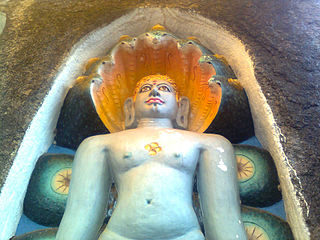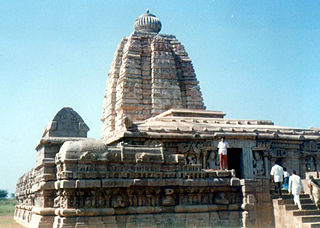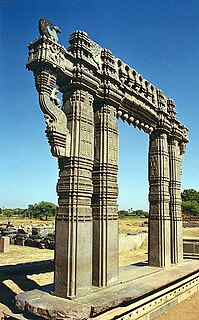
Khammam Fort is a fort in the city of Khammam, Telangana, India constructed by Musunuri Nayaks. It served as an impregnable citadel during various regimes of different dynasties, including the Musunuri Nayaks, Qutb Shahi’s and Asaf Jahis. The fort was situated in a very vast area in the heart of the City of Khammam. It was notified as a protected monument by the Archaeology Department several decades ago. Despite decades of neglect, the historical edifice, which once flourished with regal opulence, presents its alluring charm due to its architectural splendor.

Warangal is a city in the Indian state of Telangana. It serves as the district headquarters of both Warangal Urban District and Warangal Rural District. With a population of 830,281 per 2011 Census of India, and spreading over an 406 km2 (157 sq mi), Warangal is the second most populous city in the state after the capital Hyderabad.

The Kakatiya dynasty was a South Indian dynasty whose capital was Orugallu, now known as Warangal. It was eventually conquered by the Delhi Sultanate.
Reddy is a caste that originated in India, predominantly settled in Andhra Pradesh and Telangana. They are classified as a forward caste.

Hanmakonda is a neighbourhood and one of the three cities constituting the Tri-City of Warangal in the Indian state of Telangana. It is administered by Greater Warangal Municipal Corporation.

Mellacheruvu is a village in Suryapet district of the Indian state of Telangana. It is located in Mellachervu mandal of Kodad revenue division..It is about 64km from the district headquarters Suryapet.

Warangal Urban district is a district located in the northern region of the Indian state of Telangana. The district headquarters are located at Hanamkonda.

Alampur is a town situated in Jogulamba Gadwal district in the Indian state of Telangana. Alampur is a popular Hindu pilgrimage site in Shaktism and is also home to the Navabrahma Temples, a group of nine temples dedicated to Shiva built in the seventh and eighth century CE. It is the meeting point of the rivers Tungabhadra and Krishna and is referred to as Dakshina Kasi and is also considered the western gateway to Srisailam. The sacredness of Alampur is mentioned in the Skanda Purana. It is surrounded by the Nallamala hills and is situated on the left bank of the Tungabhadra river.

Ramappa Temple also known as the Ramalingeswara temple, is located 77 km from Warangal, 15km from Mulugu, 209 km from Hyderabad in the state of Telangana in southern India. It lies in a valley at Palampet village of Venkatapur Mandal, in erstwhile Mulug Taluq of Mulugu district, a tiny village long past its days of glory in the 13th and 14th centuries. An inscription in the temple dates it to the year 1213 CE and says it was built by a General Recherla Rudra Reddy, during the period of the Kakatiya ruler Ganapati Deva.

Panagal or Panagallu is a historic town located 4 km from Nalgonda town in Telangana, India. Panagal was one of the capitals of Kunduru Chodas who ruled parts of eastern Telangana in the 11th and 12th centuries.

The Thousand Pillar Temple or Rudreswara Swamy Temple is a historic Hindu temple located in the town of Hanamakonda, Telangana State, India. It is dedicated to Lord Shiva, Vishnu and Surya. Thousand Pillar Temple, along with Warangal Fort, Kakatiya Kala Thoranam and Ramappa Temple are added to the tentative list of World Heritage sites recognised by UNESCO.

Warangal Fort is located in Warangal District, Telangana, India. It was the capital city of Kakatiyas and Musunuri Nayakas. It appears to have existed since at least the 12th century when it was the capital of the Kakatiya dynasty. The fort has four ornamental gates, known as Kakatiya Kala Thoranam, that originally formed the entrances to a now ruined great Shiva temple. The Kakatiyan arch has been adopted and officially incorporated into the emblem of Telangana after the state bifurcation. The Fort is included in the "tentative list" of UNESCO World Heritage Site. The Monument was submitted by the Permanent Delegation of India to UNESCO on 10/09/2010.

Pachala Someswara temple is a Saivite Hindu temple located in Panagal of Nalgonda district, Telangana, India. It is a popular pilgrimage site during Maha Sivaratri. The idol of the deity here is carved out of green onyx which gives the temple its name - Pacha in Telugu means Green. The temple is in close proximity to Chaya Someswara Temple, another Saivite shrine in Panagal. The temples dates to 11th to 12th centuries CE and was probably built during the rule of Kunduru Chodas and Prataparudra I of Kakatiya Empire over the Panagal region.

Chaya Someswara temple, also known as Trikutalayam, is a Saivite Hindu temple located in Panagal, Nalgonda district of Telangana, India. It is a popular pilgrimage site during Maha Sivaratri. The temple has three sanctum sanctorum and hence is also called Trikutalayam. The temple has stepped pyramidal sikharas and was probably built in the 11th and 12th centuries CE during the rule of Kunduru Chodas and Prataparudra I of Kakatiya Empire over the Panagal region.
Telangana State Tourism Development Corporation (TSTDC) is a state government agency which promotes tourism in Telangana, a state in the Southern region of India. The retired Director General of Police Pervaram Ramulu is the appointed First chairman of Telangana State Tourism. Tourist attractions in Telangana include historical places, monuments, forts, water falls, forests and temples.

Kakatiya Kala Thoranam is a historical arch in the Warangal district, of the Indian state of Telangana. The Warangal Fort has four ornamental gates which originally formed the gates to the destroyed great Shiva temple which are known as Kakatiya Kala Thoranam or Warangal Gates. The architectural feature of these historical arches of the Warangal Fort has been adopted as the symbol of the Kakatiya Dynasty and has been officially incorporated as the Emblem of Telangana for the state of Telangana. These gates or arches in the Warangal Fort are said to have similarities with gateways of the Sanchi stupa; this fact has been endorsed by many.

The Culture of Telangana in India has a cultural history of about 5,000 years. The region emerged as the foremost centre of culture in Indian subcontinent during the rule of Kakatiya, the Qutb Shahi and Asaf Jahi dynasties—. The rulers' patronage and interest for arts and culture transformed Telangana into a unique multi-cultural region where two different cultures coexist together, thus making Telangana the representative of the Deccan Plateau and its heritage with Warangal and Hyderabad being its epicenter. The regions' major cultural events celebrated are "Kakatiya Festival" and Deccan Festival along with religious festivals Bonalu, Bathukamma, Dasara, Ugadi, Sankranthi, Milad un Nabi and Ramadan.

Pushpagiri Temple Complex is a temple complex located in Kadapa district in Andhra Pradesh, India. Founded around 7th Century CE, it houses some of the oldest temple congregations in the region. It is not to be confused with the Buddhist Pushpagiri Vihara ruins in Odisha.

Suryapet district is a district in the Indian state of Telangana. The city of Suryapet is the district headquarters. Suryapet district is carved out of erstwhile Nalgonda district. The district shares boundaries with Nalgonda, Khammam, Yadadri, Jangaon and Mahabubabad districts and with Andhra Pradesh state.





























